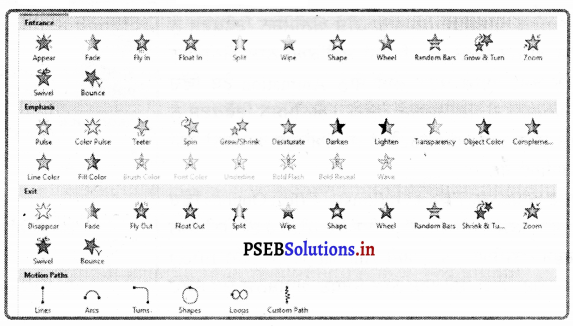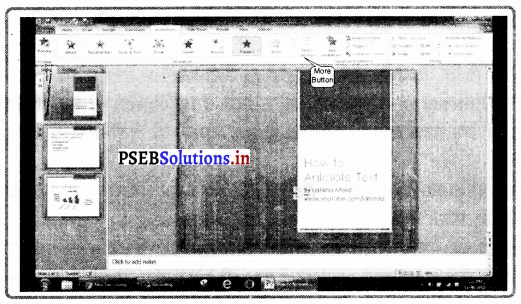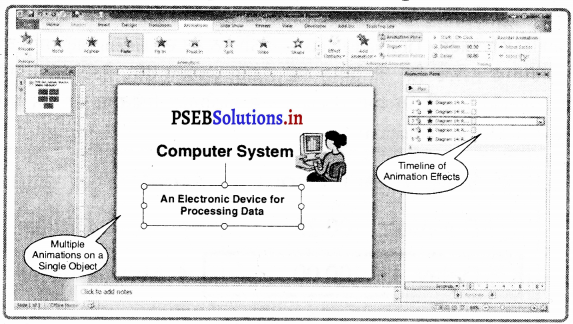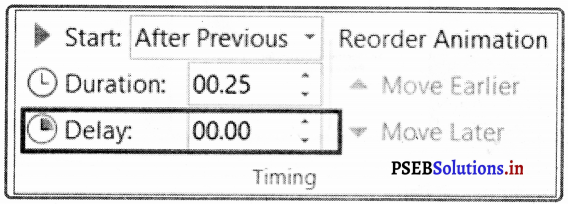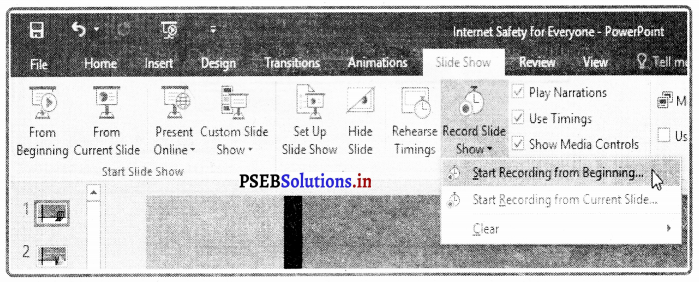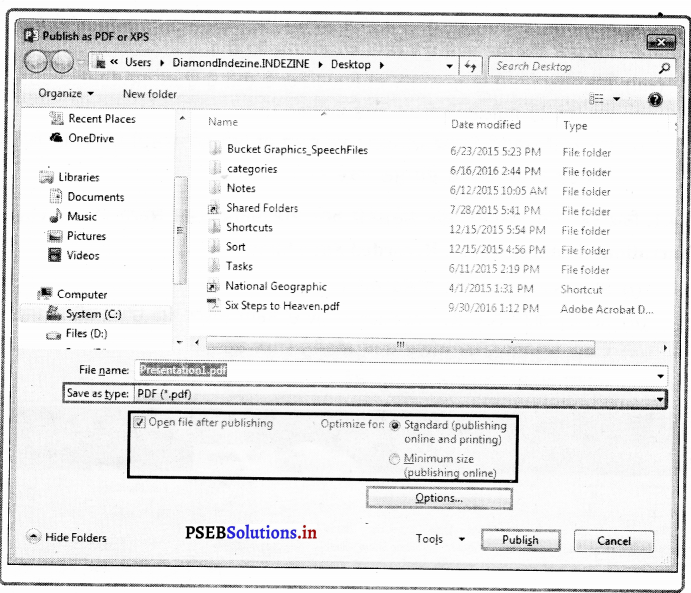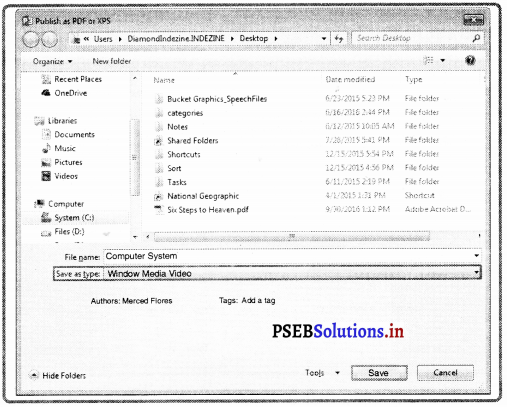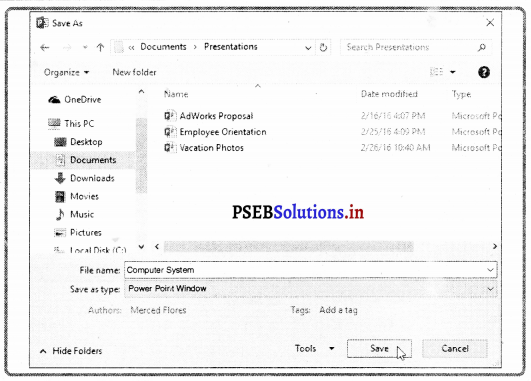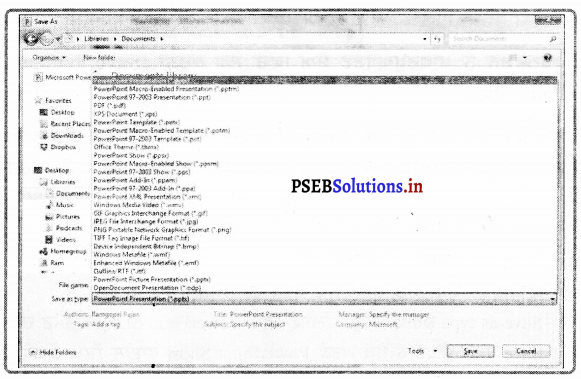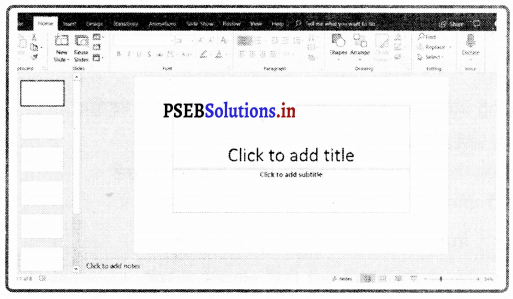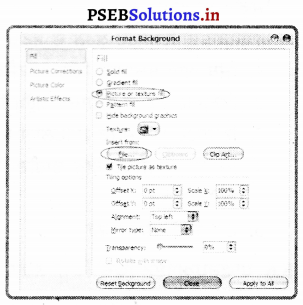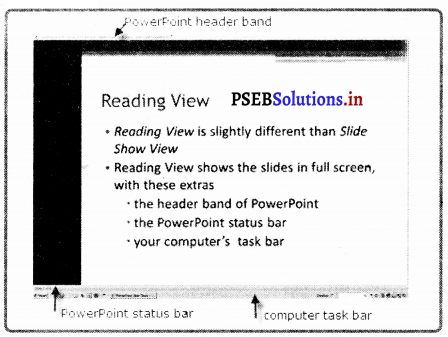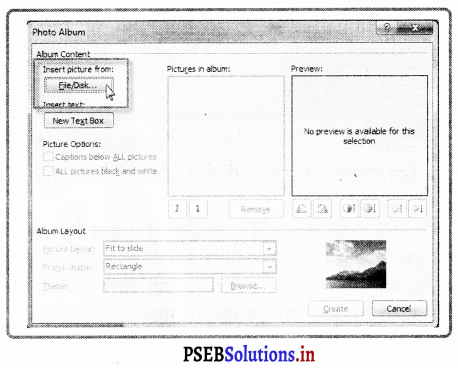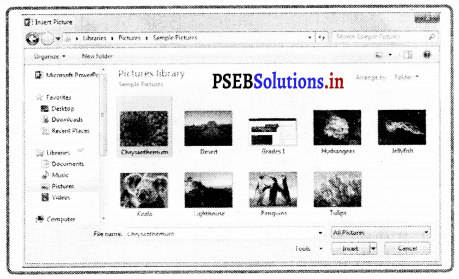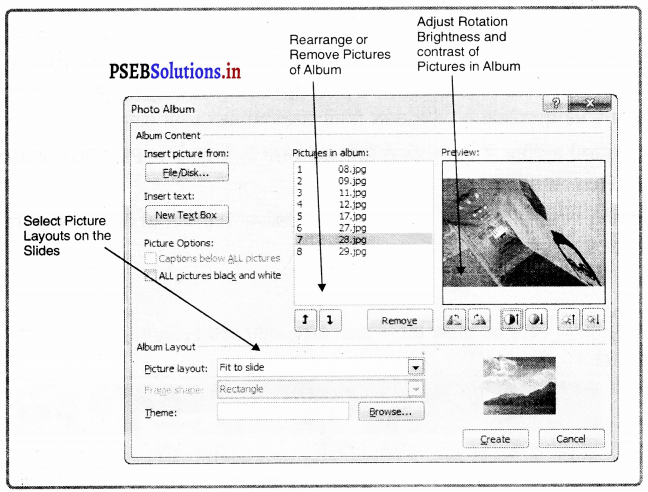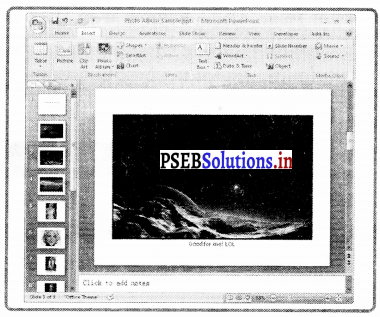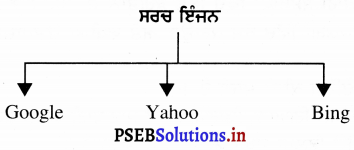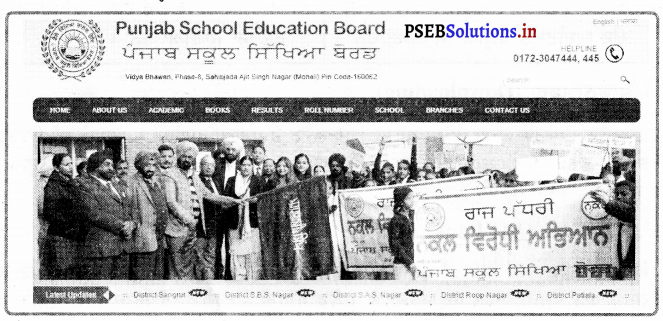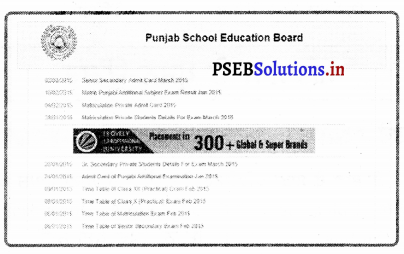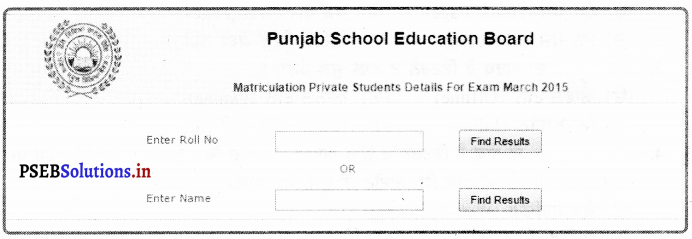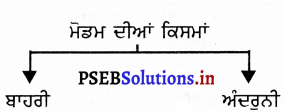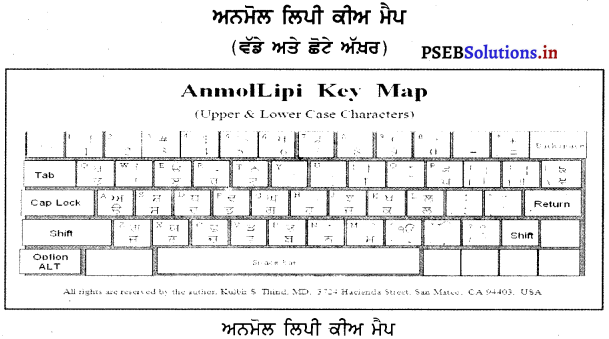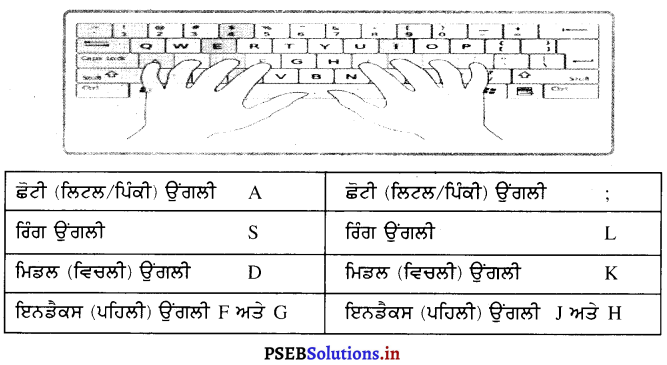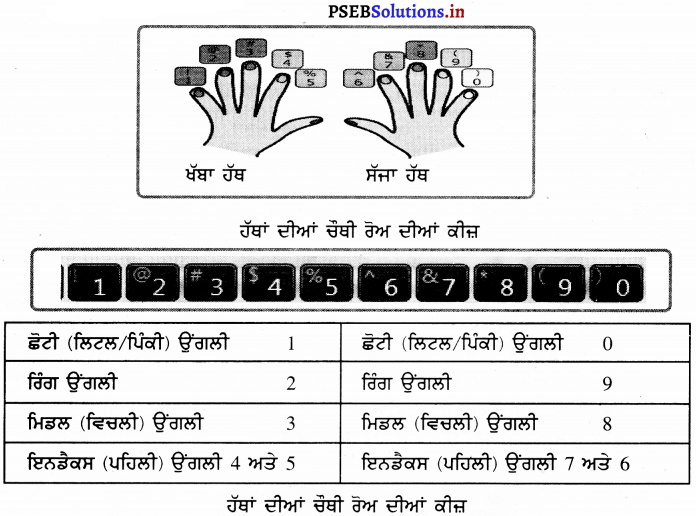This PSEB 8th Class Computer Notes Chapter 8 ਮੈਮਰੀ ਯੂਨਿਟਸ will help you in revision during exams.
PSEB 8th Class Computer Notes Chapter 8 ਮੈਮਰੀ ਯੂਨਿਟਸ
ਮੈਮਰੀ ਕੀ ਹੈ ? (What is Memory ?)
ਕੰਪਿਊਟਰ ਮੈਮਰੀ ਦਿਮਾਗ ਦੀ ਤਰ੍ਹਾਂ ਹੈ ।
ਮੈਮਰੀ ਉਹ ਜਗ੍ਹਾ ਹੁੰਦੀ ਹੈ ਜਿਸ ਵਿਚ ਕੰਪਿਊਟਰ ਡਾਟਾ ਅਤੇ ਕੰਮ ਕਰਨ ਲਈ ਜ਼ਰੂਰੀ ਹਦਾਇਤਾਂ ਨੂੰ ਸਟੋਰ ਕਰਕੇ ਰੱਖਦਾ ਹੈ । ਇਸ ਵਿਚ ਕੰਮ ਕਰਨ ਵਾਸਤੇ ਡਾਟਾ ਅਤੇ ਹਿਦਾਇਤਾਂ ਹੁੰਦੀਆਂ ਹਨ । ਮੈਮਰੀ ਛੋਟੇ ਹਿੱਸਿਆਂ ਵਿਚ ਵੰਡੀ ਹੁੰਦੀ ਹੈ ਜਿਸ ਨੂੰ ਸੈੱਲ ਕਹਿੰਦੇ ਹਨ । ਹਰ ਸੈੱਲ ਦਾ ਐਡਰੈਸ ਵੱਖਰਾ ਹੁੰਦਾ ਹੈ ।
ਮੈਮਰੀ ਯੂਨਿਟਸ/ਇਕਾਈਆਂ (Memory Units)
ਮੈਮਰੀ ਸਮਰੱਥਾ ਨੂੰ ਬਾਈਟਸ ਵਿਚ ਮਾਪਿਆ ਜਾਂਦਾ ਹੈ । ਇਸ ਦੇ ਕੁੱਝ ਮੁੱਢਲੇ ਯੂਨਿਟ ਹਨ ਜੋ ਹੇਠ ਅਨੁਸਾਰ ਹਨ :-
ਬਿਟ (Bit) (ਬਾਈਨਰੀ ਡਿਜਿਟ) : ਇਕ ਬਿਟ ਜਾਂ ਬਾਈਨਰੀ ਡਿਜਿਟ ਨੂੰ ਲੋਜੀਕਲ 0 ਅਤੇ 1 ਰਾਹੀਂ ਪ੍ਰਦਰਸ਼ਿਤ ਕੀਤਾ ਜਾ ਸਕਦਾ ਹੈ ।
- ਨਿਬਲ (Nibble) – ਚਾਰ ਬਿਟਸ ਦੇ ਸਮੂਹ ਨੂੰ ਨਿਬਲ ਕਿਹਾ ਜਾਂਦਾ ਹੈ ।
- ਬਾਈਟ (Byte) – ਅੱਠ ਬਿਟਸ ਦੇ ਸਮੂਹ ਨੂੰ ਬਾਈਟ ਕਿਹਾ ਜਾਂਦਾ ਹੈ ।
ਬਾਈਟ ਉਹ ਸਭ ਤੋਂ ਛੋਟੀ ਇਕਾਈ ਹੈ ਜਿਸ ਰਾਹੀਂ ਕਿਸੇ ਡਾਟਾ ਆਈਟਮ ਜਾਂ ਅੱਖਰ ਨੂੰ ਪੇਸ਼ ਕੀਤਾ ਜਾ ਸਕਦਾ ਹੈ । - ਵਰਡ (Word) – ਕੰਪਿਊਟਰ ਵਿੱਚ ਇੱਕ ਸ਼ਬਦ ਕੁਝ ਨਿਰਧਾਰਿਤ ਬਿਟਸ ਦਾ ਸਮੂਹ ਹੁੰਦਾ ਹੈ ਜੋ ਕਿ ਇੱਕ ਇਕਾਈ ਵਜੋਂ ਪ੍ਰੋਸੈੱਸ ਕੀਤਾ ਜਾਂਦਾ ਹੈ । ਇੱਕ ਸ਼ਬਦ (ਕੰਪਿਊਟਰ ਵਿੱਚ) ਦੀ ਲੰਬਾਈ ਨੂੰ ਵਰਡਸਾਈਜ਼ ਜਾਂ ਵਰਡ-ਲੈਬ ਕਿਹਾ ਜਾਂਦਾ ਹੈ । ਇਹ 8-ਬਿਟਸ ਜਿੰਨਾ ਛੋਟਾ ਅਤੇ 96-ਬਿਟਸ ਜਿੰਨਾ ਵੱਡਾ ਹੋ ਸਕਦਾ ਹੈ ।
ਕੰਪਿਊਟਰ ਦੀ ਮੈਮਰੀ ਨੂੰ ਮਾਪਣ ਦੀਆਂ ਇਕਾਈਆਂ-
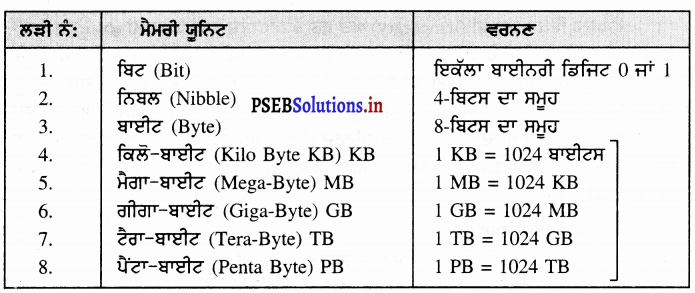
![]()
ਮੈਮਰੀ ਦੀਆਂ ਕਿਸਮਾਂ (Type of Memory)
ਮੈਮਰੀ ਹੇਠ ਲਿਖੇ ਪ੍ਰਕਾਰ ਦੀ ਹੁੰਦੀ ਹੈ-

ਇਨਟਰਨਲ ਮੈਮਰੀ (Internal Memory)
ਇਹ ਮੈਮਰੀ ਸੀ.ਪੀ.ਯੂ. ਦੇ ਅੰਦਰ ਹੁੰਦੀ ਹੈ । ਇਸ ਦੀ ਸਮਰੱਥਾ ਸਭ ਤੋਂ ਘੱਟ ਹੁੰਦੀ ਹੈ ।
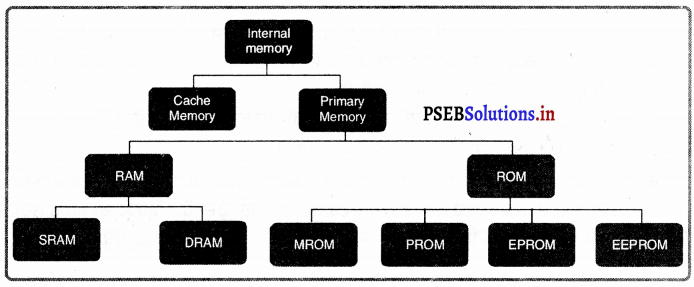
1. CPU ਰਜਿਸਟਰਸ (CPU Registers).
CPU ਰਜਿਸਟਰ ਇੱਕ ਅਸਥਾਈ (temporary) ਅਤੇ ਸਭ ਤੋਂ ਵੱਧ ਤੇਜ਼ ਰਫ਼ਤਾਰ ਵਾਲੀ ਕੰਪਿਊਟਰ ਮੈਮਰੀ ਹੈ ਜੋ CPU ਅੰਦਰ ਮੌਜੂਦ ਹੁੰਦੀ ਹੈ । ਇਹਨਾਂ ਦੀ ਵਰਤੋਂ CPU ਦੁਆਰਾ ਤੁਰੰਤ ਵਰਤੇ ਜਾਣ ਵਾਲੇ ਡਾਟਾ ਅਤੇ ਹਦਾਇਤਾਂ ਨੂੰ ਸਟੋਰ/ਟ੍ਰਾਂਸਫਰ ਕਰਨ ਲਈ ਕੀਤੀ ਜਾਂਦੀ ਹੈ । CPU ਦੁਆਰਾ ਵਰਤੇ ਜਾਂਦੇ ਰਜਿਸਟਰਜ਼ ਨੂੰ ਅਕਸਰ ਪ੍ਰੋਸੈਸਰ-ਰਜਿਸਟਰ ਕਿਹਾ ਜਾਂਦਾ ਹੈ | ਪ੍ਰੋਸੈਸਰ ਰਜਿਸਟਰਜ਼ ਵਿੱਚ ਹਦਾਇਤਾਂ, ਮੈਮਰੀ ਐਡਰੈਸ, ਜਾਂ ਕੋਈ ਵੀ ਡਾਟਾ ਰੱਖਿਆ ਜਾ ਸਕਦਾ ਹੈ । CPU ਰਜਿਸਟਰਜ਼ ਦੀਆਂ ਆਮ ਉਦਾਹਰਣਾਂ ਹਨ-ਇਨਸਟਰਕਸ਼ਨ ਰਜਿਸਟਰ (IR), ਮੈਮਰੀ ਬਫਰ ਰਜਿਸਟਰ (MBR), ਮੈਮੋਰੀ ਡਾਟਾ ਰਜਿਸਟਰ (MDR), ਅਤੇ ਮੈਮੋਰੀ ਐਡਰੈਸ ਰਜਿਸਟਰ (MAR) ।
2. ਕੈਸ਼ ਮੈਮਰੀ (Cache Memory)
ਇਹ ਮੈਮਰੀ ਸੀ.ਪੀ. ਯੂ. ਅਤੇ ਪ੍ਰਾਈਮਰੀ ਮੈਮਰੀ ਦੇ ਵਿਚਕਾਰ ਹੁੰਦੀ ਹੈ ।
ਕੈਸ਼ ਮੈਮਰੀ ਦੇ ਲਾਭ – ਕੈਸ਼ ਮੈਮਰੀ ਦੇ ਲਾਭ ਹੇਠ ਲਿਖੇ ਅਨੁਸਾਰ ਹਨ :
- ਕੈਸ਼ ਮੈਮਰੀ ਮੁੱਖ ਮੈਮਰੀ ਤੋਂ ਤੇਜ਼ ਹੁੰਦੀ ਹੈ ।
- ਮੁੱਖ ਮੈਮਰੀ ਦੇ ਮੁਕਾਬਲੇ ਇਸ ਦਾ ਐਕਸੈਸ ਟਾਈਮ ਘੱਟ ਹੁੰਦਾ ਹੈ ।
- ਕੈਸ਼ ਮੈਮਰੀ ਉਸ ਪ੍ਰੋਗਰਾਮ ਨੂੰ ਸਟੋਰ ਕਰਦੀ ਹੈ, ਜਿਹੜਾ ਕਿ ਘੱਟ ਸਮੇਂ ਵਿੱਚ ਹੀ ਲਾਗੂ ਹੋਣਾ ਹੁੰਦਾ ਹੈ ।
- ਕੈਸ਼ ਮੈਰੀ ਡਾਟਾ ਨੂੰ ਅਸਥਾਈ ਤੌਰ ‘ਤੇ (Temporory) ਸਟੋਰ ਕਰਦੀ ਹੈ ।
ਕੈਸ਼ ਮੈਮਰੀ ਦੀਆਂ ਹਾਨੀਆਂ-ਕੈਸ਼ ਮੈਮਰੀ ਦੀਆਂ ਹਾਨੀਆਂ ਹੇਠ ਲਿਖੇ ਅਨੁਸਾਰ ਹਨ :
- ਕੈਸ਼ ਮੈਮਰੀ ਦੀ ਸਮਰੱਥਾ ਬਹੁਤ ਘੱਟ ਹੁੰਦੀ ਹੈ ।
- ਕੈਸ਼ ਮੈਮਰੀ ਦੀ ਕੀਮਤ ਬਹੁਤ ਜ਼ਿਆਦਾ ਹੁੰਦੀ ਹੈ ।
3. ਪ੍ਰਾਈਮਰੀ ਮੈਮਰੀ (Primary Memory)
ਪ੍ਰਾਈਮਰੀ ਮੈਮਰੀ ਉਹ ਹੁੰਦੀ ਹੈ ਜੋ ਕੰਪਿਊਟਰ ਦੇ ਚਲਦੇ ਸਮਾਂ ਡਾਟੇ ਅਤੇ ਨਿਰਦੇਸ਼ ਸਟੋਰ ਕਰਦੀ ਹੈ । ਇਹ ਦੋ ਪ੍ਰਕਾਰ ਦੀ ਹੁੰਦੀ ਹੈ :
I. ਰੈਮ
II. ਰੋਮ ।
ਪ੍ਰਾਇਮਰੀ ਮੈਮਰੀ ਦੀਆਂ ਵਿਸ਼ੇਸ਼ਤਾਵਾਂ ਅਤੇ ਗੁਣ :
- ਇਹ ਸੈਮੀ-ਕੰਡਕਟਰ ਮੈਮਰੀ ਹੁੰਦੀ ਹੈ ਅਤੇ ਇਸ ਨੂੰ ਮੁੱਖ ਮੈਮਰੀ ਵਜੋਂ ਜਾਣਿਆ ਜਾਂਦਾ ਹੈ ।
- ਇਹ ਅਸਥਿਰ ਮੈਮਰੀ ਹੁੰਦੀ ਹੈ ਕਿਉਂਕਿ ਇਸ ਦਾ ਡਾਟਾ ਬਿਜਲੀ ਬੰਦ ਹੋਣ ‘ਤੇ ਨਸ਼ਟ ਹੋ ਜਾਂਦਾ ਹੈ ।
- ਇਹ ਕੰਪਿਊਟਰ ਦੀ ਕੰਮ-ਕਾਜੀ ਮੈਮਰੀ ਹੁੰਦੀ ਹੈ ।
- ਇਹ ਸੈਕਡੰਰੀ ਮੈਮਰੀ ਨਾਲੋਂ ਤੇਜ਼ ਹੁੰਦੀ ਹੈ ਪਰ CPU ਰਜ਼ਿਸਟਰਾਂ ਨਾਲੋਂ ਹੌਲੀ ਹੁੰਦੀ ਹੈ ।
ਕੰਪਿਊਟਰ ਪ੍ਰਾਇਮਰੀ ਮੈਮਰੀ ਤੋਂ ਬਿਨਾਂ ਕੰਮ ਨਹੀਂ ਕਰ ਸਕਦਾ ।
I. ਰੈਮ (RAM) – RAM ਦਾ ਪੂਰਾ ਨਾਮ Random Access Memory ਹੈ । ਇਹ ਕੰਪਿਊਟਰ ਦਾ ਉਹ ਡਾਟਾ ਅਤੇ ਹਿਦਾਇਤਾਂ ਸਟੋਰ ਕਰਦਾ ਹੈ ਜਿਸ ਤੇ ਕੰਪਿਊਟਰ ਕੰਮ ਕਰ ਰਿਹਾ ਹੁੰਦਾ ਹੈ । ਇਹ ਮੈਮਰੀ ਸਥਿਰ ਨਹੀਂ ਹੁੰਦੀ ਹੈ । ਬਿਜਲੀ ਬੰਦ ਹੋਣ ਨਾਲ ਇਸ ਦਾ ਡਾਟਾ ਨਸ਼ਟ ਹੋ ਜਾਂਦਾ ਹੈ । ਇਸ ਤੋਂ ਬਗੈਰ ਕੰਪਿਊਟਰ ਕੰਮ ਨਹੀਂ ਕਰ ਸਕਦਾ ।
 ਰੈਮ ਦੀ ਸ਼੍ਰੇਣੀ ਵੰਡ – ਰੈਮ ਨੂੰ ਹੇਠ ਲਿਖੀਆਂ ਸ਼੍ਰੇਣੀਆਂ ਵਿਚ ਵੰਡਿਆ ਜਾ ਸਕਦਾ ਹੈ-
ਰੈਮ ਦੀ ਸ਼੍ਰੇਣੀ ਵੰਡ – ਰੈਮ ਨੂੰ ਹੇਠ ਲਿਖੀਆਂ ਸ਼੍ਰੇਣੀਆਂ ਵਿਚ ਵੰਡਿਆ ਜਾ ਸਕਦਾ ਹੈ-
1. ਸਟੈਟਿਕ ਰੈਮ – ਇਹ ਮੈਮਰੀ ਉਦੋਂ ਤਕ ਡਾਟਾ ਸਟੋਰ ਕਰਕੇ ਰੱਖਦੀ ਹੈ ਜਦ ਤਕ ਇਸ ਵਿਚ ਬਿਜਲੀ ਆ ਰਹੀ ਹੁੰਦੀ ਹੈ । ਇਸ ਵਿਚ ਛੇ ਝਾਂਜ਼ਿਸਟਰਾਂ ਦੀ ਵਰਤੋਂ ਕੀਤੀ ਜਾਂਦੀ ਹੈ । ਇਸ ਵਿਚ ਕੋਈ ਕਪੈਸਟਰ ਨਹੀਂ ਲੱਗਿਆ ਹੁੰਦਾ । ਝਾਂਜ਼ਿਸਟਰਾਂ ਦੀ ਲੀਕੇਜ਼ ਨੂੰ ਰੋਕਣ ਲਈ ਬਿਜਲੀ ਦੀ ਲੋੜ ਨਹੀਂ ਪੈਂਦੀ ।ਇਸ ਲਈ ਇਸ ਨੂੰ ਰਿਫਰੈਂਸ ਕਰਨ ਦੀ ਜ਼ਰੂਰਤ ਨਹੀਂ ਪੈਂਦੀ ।
![]()
ਵਿਸ਼ੇਸ਼ਤਾਵਾਂ – ਸਟੈਟਿਕ ਰੈਮ ਦੀਆਂ ਹੇਠ ਲਿਖੀਆਂ ਵਿਸ਼ੇਸ਼ਤਾਵਾਂ ਹਨ-
- ਇਹ ਜ਼ਿਆਦਾ ਸਮਾਂ ਚਲਦੀ ਹੈ ।
- ਇਸ ਨੂੰ ਰਿਫਰੈਂਸ ਕਰਨ ਦੀ ਲੋੜ ਨਹੀਂ ਹੁੰਦੀ ।
- ਇਹ ਤੇਜ਼ ਹੁੰਦੀ ਹੈ ।
- ਇਹ ਕੈਸ਼ ਮੈਮਰੀ ਵਜੋਂ ਵਰਤੀ ਜਾਂਦੀ ਹੈ ।
- ਇਸ ਦਾ ਆਕਾਰ ਵੱਡਾ ਹੁੰਦਾ ਹੈ ।
- ਇਹ ਮਹਿੰਗੀ ਹੁੰਦੀ ਹੈ ।
- ਇਹ ਜ਼ਿਆਦਾ ਬਿਜਲੀ ਵਰਤਦੀ ਹੈ ।
2. ਡਾਇਨੈਮਿਕ ਰੈਮ – ਇਸ ਮੈਮਰੀ ਨੂੰ ਵਾਰ-ਵਾਰ ਰਿਫਰੈਸ਼ ਕਰਨਾ ਪੈਂਦਾ ਹੈ । ਇਸ ਤੇ ਰਿਫਰੈਸ਼ ਸਰਕਟ ਲੱਗਿਆ ਹੁੰਦਾ ਹੈ ਜੋ ਕਈ ਸੌ ਵਾਰ ਪ੍ਰਤੀ ਸੈਕਿੰਡ ਨਾਲ ਚਲਦਾ ਹੈ । ਇਹ ਮੈਮਰੀ ਸਸਤੀ ਅਤੇ ਛੋਟੀ ਹੁੰਦੀ ਹੈ । ਇਸ ਵਿਚ ਝਾਂਜ਼ਿਸਟਰ ਅਤੇ ਕਪੈਸਟਰ ਲੱਗੇ ਹੁੰਦੇ ਹਨ ।
ਵਿਸ਼ੇਸ਼ਤਾਵਾਂ – ਡਾਇਨੈਮਿਕ ਰੈਮ ਦੀਆਂ ਹੇਠ ਲਿਖੀਆਂ ਵਿਸ਼ੇਸ਼ਤਾਵਾਂ ਹਨ-
- ਇਹ ਘੱਟ ਸਮੇਂ ਤੱਕ ਚੱਲਦੀ ਹੈ ।
- ਇਸ ਨੂੰ ਰਿਫਰੈਸ਼ ਕਰਨ ਦੀ ਲੋੜ ਪੈਂਦੀ ਹੈ ।
- ਇਸ ਦੀ ਰਫਤਾਰ ਘੱਟ ਹੁੰਦੀ ਹੈ ।
- ਇਸ ਨੂੰ ਰੈਮ ਦੀ ਤਰ੍ਹਾਂ ਵਰਤਿਆ ਜਾਂਦਾ ਹੈ ।
- ਇਸਦਾ ਆਕਾਰ ਘੱਟ ਹੁੰਦਾ ਹੈ ।
- ਇਹ ਮੈਮਰੀ ਮਹਿੰਗੀ ਹੁੰਦੀ ਹੈ ।
- ਇਹ ਬਿਜਲੀ ਦੀ ਘਟ ਖਪਤ ਕਰਦੀ ਹੈ ।
II. ਰੋਮ (ROM) – ਰੋਮ ਦਾ ਪੂਰਾ ਨਾਮ ਰੀਡ ਉਨਲੀ ਮੈਮਰੀ ਹੈ । ਇਹ ਉਹ ਮੈਮਰੀ ਹੈ ਜਿਸ ਨੂੰ ਸਿਰਫ਼ ਪੜ੍ਹਿਆ ਜਾ ਸਕਦਾ ਹੈ ਇਸ ਤੇ ਲਿਖਿਆ ਨਹੀਂ ਜਾ ਸਕਦਾ । ਇਹ ਸਥਾਈ ਮੈਮਰੀ ਹੁੰਦੀ ਹੈ । ਇਸ ਵਿਚ ਕੰਪਿਊਟਰ ਸ਼ੁਰੂ ਕਰਨ ਦੀਆਂ ਹਿਦਾਇਤਾਂ ਹੁੰਦੀਆਂ ਹਨ । ਇਸ ਦੀ ਵਰਤੋਂ ਕਈ ਪ੍ਰਕਾਰ ਦੀਆਂ ਇਲੈੱਕਟ੍ਰਾਨਿਕ ਮਸ਼ੀਨਾਂ ਵਿਚ ਵੀ ਕੀਤੀ ਜਾਂਦੀ ਹੈ ।
ਰੋਮ ਦੀਆਂ ਕਿਸਮਾਂ-ਰੋਮ ਹੇਠ ਲਿਖੇ ਪ੍ਰਕਾਰ ਦੀ ਹੁੰਦੀ ਹੈ-
(i) Masked ROM – ਇਹ ਤਾਰਾਂ ਦੇ ਬਣੇ ਯੰਤਰ ਹੁੰਦੇ ਹਨ ਜਿਨ੍ਹਾਂ ਨੂੰ ਪਹਿਲਾਂ ਪ੍ਰੋਗਰਾਮ ਕੀਤਾ ਗਿਆ ਹੁੰਦਾ ਹੈ । ਇਹ ਸਸਤੀਆਂ ਹੁੰਦੀਆਂ ਹਨ ।

(ii) PROM : PROM ਉਹ ਮੈਮਰੀ ਹੈ ਜੋ ਸਿਰਫ ਇਕ ਬਾਰ ਬਦਲੀ ਜਾ ਸਕਦੀ ਹੈ । ਖਾਲੀ PROM ਤੇ ਇਕ ਵਾਰ ਡਾਟਾ ਭਰਿਆ ਜਾ ਸਕਦਾ ਹੈ । ਫਿਰ ਉਸ ਨੂੰ ਮਿਟਾਇਆ ਨਹੀਂ ਜਾ ਸਕਦਾ ।

(iii) EPROM: EPROM ਤੋਂ ਡਾਟਾ ਅਲਟ੍ਰਾਵਾਇਲਟ ਕਿਰਨਾਂ ਰਾਹੀਂ ਮਿਟਾਇਆ ਜਾ ਸਕਦਾ ਹੈ । ਇਸ ਨੂੰ ਪ੍ਰੋਗਰਾਮ ਕਰਦੇ ਸਮੇਂ ਇਲੈੱਕਟ੍ਰਿਕ ਚਾਰਜ ਦੀ ਵਰਤੋਂ ਕੀਤੀ ਜਾਂਦੀ ਹੈ । ਇਸ ਚਾਰਜ ਨੂੰ ਮਿਟਾਉਣ ਵਾਸਤੇ ਅਲਟ੍ਰਾਵਾਇਲਟ ਕਿਰਨਾਂ ਦੀ ਵਰਤੋਂ ਕੀਤੀ ਜਾਂਦੀ ਹੈ । ਇਸ ਵਿਚ ਚਾਰਜ 10 ਸਾਲ ਤਕ ਰਹਿ ਸਕਦਾ ਹੈ ।
(iv) EEPROM : ਇਸ ਰੋਮ ਨੂੰ ਬਿਜਲੀ ਨਾਲ ਪ੍ਰੋਗਰਾਮ ਕੀਤਾ ਜਾ ਸਕਦਾ ਹੈ । ਇਸ ਨੂੰ ਲਗਪਗ 10000 ਵਾਰ ਮਿਟਾਇਆ ਅਤੇ ਲਿਖਿਆ ਜਾ ਸਕਦਾ ਹੈ । ਇਸ ਨੂੰ ਪੂਰੀ ਜਾਂ ਕਿਸੇ ਹਿੱਸੇ ਨੂੰ ਮਿਟਾਇਆ ਜਾ ਸਕਦਾ ਹੈ ।
ROM ਦੇ ਲਾਭ – ਰੋਮ ਦੇ ਲਾਭ ਹੇਠ ਲਿਖੇ ਅਨੁਸਾਰ ਹਨ :
- ਇਹ ਸਥਾਈ ਮੈਮਰੀ ਹੁੰਦੀ ਹੈ ।
- ਇਹਨਾਂ ਵਿਚਲਾ ਡਾਟਾ ਕਿਸੇ ਦੁਰਘਟਨਾਵੱਸ ਵੀ ਨਹੀਂ ਬਦਲ ਸਕਦਾ ।
- ਇਹ ਰੈਮ ਨਾਲੋਂ ਸਸਤੀ ਹੁੰਦੀ ਹੈ ।
- ਇਹਨਾਂ ਦੀ ਪਰਖ ਕਰਨੀ ਅਸਾਨ ਹੁੰਦੀ ਹੈ ਅਤੇ ਇਹ ਰੈਮ ਨਾਲੋਂ ਜ਼ਿਆਦਾ ਭਰੋਸੇਲਾਇਕ ਹੁੰਦੀਆਂ ਹਨ ।
- ਇਹ ਸਟੈਟਿਕ ਹੁੰਦੀਆਂ ਹਨ ਅਤੇ ਇਹਨਾਂ ਨੂੰ ਰਿਫਰੈਸ਼ ਕਰਨ ਦੀ ਜ਼ਰੂਰਤ ਨਹੀਂ ਪੈਂਦੀ ।
ਐਕਸਟਰਨਲ ਮੈਮਰੀ (External Memory)
ਐਕਸਟਰਨਲ ਮੈਮਰੀ ਉਹ ਮੈਮਰੀ ਹੁੰਦੀ ਹੈ ਜਿਸ ਦੀ ਵਰਤੋਂ ਡਾਟੇ ਨੂੰ ਪੱਕੇ ਤੌਰ ਤੇ ਸਟੋਰ ਕਰਨ ਵਾਸਤੇ ਕੀਤੀ ਜਾਂਦੀ ਹੈ । ਇਸ ਨੂੰ ਸੈਕੰਡਰੀ, ਐਗਜੂਅਲਰੀ ਜਾਂ ਸਥਾਈ ਮੈਮਰੀ ਵੀ ਕਿਹਾ ਜਾਂਦਾ ਹੈ । ਇਸ ਮੈਮਰੀ ਤੋਂ ਡਾਟਾ ਪਹਿਲਾਂ ਪ੍ਰਾਈਮਰੀ ਮੈਮਰੀ ਵਿਚ ਭੇਜਿਆ ਜਾਂਦਾ ਹੈ ਅਤੇ ਫਿਰ ਸੀ. ਪੀ. ਯੂ ਵਿਚ ।
ਸੀ.ਡੀ., ਡੀ.ਵੀ.ਡੀ., ਹਾਰਡ ਡਿਸਕ ਆਦਿ ਇਸ ਦੀਆਂ ਉਦਾਹਰਨਾਂ ਹਨ ।
ਸ਼੍ਰੇਣੀ ਵੰਡ-ਸੈਕੰਡਰੀ ਮੈਮਰੀ ਨੂੰ ਹੇਠ ਲਿਖੇ ਅਨੁਸਾਰ ਸ਼੍ਰੇਣੀ ਵੰਡ ਕੀਤਾ ਜਾਂਦਾ ਹੈ ।
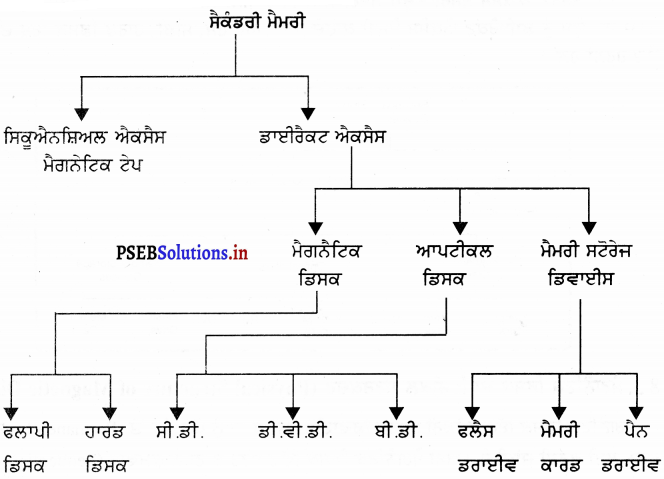
ਸੈਕੰਡਰੀ ਮੈਮਰੀ ਬਾਹਰੀ ਮੈਮਰੀ ਹੁੰਦੀ ਹੈ ਜੋ ਡਾਟਾ ਅਤੇ ਨਿਰਦੇਸ਼ ਪੱਕੇ ਤੌਰ ਤੇ ਸਟੋਰ ਕਰਨ ਵਾਸਤੇ ਵਰਤੀ ਜਾਂਦੀ ਹੈ ।
ਇਹ ਕਈ ਪ੍ਰਕਾਰ ਦੀ ਹੁੰਦੀ ਹੈ । ਸੈਕੰਡਰੀ ਮੈਮਰੀ ਦੀਆਂ ਵਿਸ਼ੇਸ਼ਤਾਵਾਂ ਅਤੇ ਗੁਣ-
- ਇਹ ਮੈਗਨੈਟਿਕ ਅਤੇ ਆਪਟੀਕਲ ਮੈਮਰੀ ਹੁੰਦੀ ਹੈ ।
- ਬੈਕਅੱਪਰਿਯੂਜ਼ਏਬਲ ਮੈਮਰੀ – ਸੈਕੰਡਰੀ ਮੈਮਰੀ ਵਿੱਚ ਡਾਟਾ ਪੱਕੇ ਤੌਰ ‘ਤੇ ਰਹਿੰਦਾ ਹੈ ਜਦੋਂ ਤੱਕ ਕਿ ਇਸ ਦੇ ਉੱਤੇ ਕੁਝ ਹੋਰ ਨਾ ਲਿਖਿਆ ਜਾਵੇ ਜਾਂ ਇਸਨੂੰ ਯੂਜ਼ਰ ਦੁਆਰਾ ਨਾ ਮਿਟਾਇਆ ਜਾਵੇ।
- ਸਥਾਈ ਮੈਮਰੀ – ਬਿਜਲੀ ਬੰਦ ਹੋਣ ਤੇ ਵੀ ਡਾਟਾ ਪੱਕੇ ਤੌਰ ‘ਤੇ ਸਟੋਰ ਰਹਿੰਦਾ ਹੈ ।
- ਭਰੋਸੇਯੋਗ – ਸੈਕੰਡਰੀ ਸਟੋਰੇਜ ਯੰਤਰਾਂ ਦੀ ਉੱਚ ਭੌਤਿਕ ਸਥਿਰਤਾ ਕਾਰਨ ਇਹਨਾਂ ਵਿੱਚ ਡਾਟਾ ਸੁਰੱਖਿਅਤ ਰਹਿੰਦਾ ਹੈ ।
- ਵਰਤੋਂ ਵਿੱਚ ਅਸਾਨੀ – ਕੰਪਿਊਟਰ ਸਾਫ਼ਟਵੇਅਰ ਦੀ ਮੱਦਦ ਨਾਲ ਅਧਿਕਾਰਿਤ (Authorized) ਲੋਕ ਡਾਟਾ ਨੂੰ ਜਲਦੀ ਲੱਭ ਸਕਦੇ ਹਨ ਅਤੇ ਵਰਤੋਂ ਕਰ ਸਕਦੇ ਹਨ ।
- ਸਮਰੱਥਾ-ਸੈਕੰਡਰੀ ਸਟੋਰੇਜ ਬਹੁਗਿਣਤੀ ਡਿਸਕਾਂ ਦੇ ਸੈੱਟਾਂ ਵਿੱਚ ਬਹੁਤ ਸਾਰਾ ਡਾਟਾ ਸਟੋਰ ਕਰ ਸਕਦਾ ਹੈ ।
- ਕੀਮਤ-ਪ੍ਰਾਇਮਰੀ ਮੈਮਰੀ ਨਾਲੋਂ ਟੇਪ ਜਾਂ ਡਿਸਕ ਉੱਤੇ ਡਾਟਾ ਨੂੰ ਸਟੋਰ ਕਰਨਾ ਕਾਫ਼ੀ ਸਸਤਾ ਪੈਂਦਾ ਹੈ ।
- ਸੀਕੁਐਨਸ਼ੀਅਲ ਐਕਸੈਸ – ਉਹ ਮੈਮਰੀ ਜਿਸ ਵਿਚ ਬਾਅਦ ਵਾਲੇ ਸਥਾਨ ਦੀ ਪਹੁੰਚ ਵਾਸਤੇ ਪਹਿਲੇ ਸਥਾਨ ਤੋਂ ਗੁਜ਼ਰਨਾ ਪੈਂਦਾ ਹੈ, ਉਸ ਨੂੰ ਸੀਕੁਐਂਨਸ਼ੀਅਲ ਮੈਮਰੀ ਕਹਿੰਦੇ ਹਨ ।
- ਡਾਇਰੈਕਟ ਐਕਸੈਸ ਮੈਮਰੀ – ਉਹ ਮੈਮਰੀ ਜਿਸ ਵਿਚ ਅਸੀਂ ਕਿਸੇ ਵੀ ਸਥਾਨ ਦੀ ਸਿੱਧੇ ਪਹੁੰਚ ਕਰ ਸਕਦੇ ਹਾਂ, ਉਸ ਨੂੰ ਡਾਇਰੈਕਟ ਐਕਸੈਸ ਮੈਮਰੀ ਕਹਿੰਦੇ ਹਨ । ਰੈਮ, ਰੋਮ, ਸੀਡੀ, ਹਾਰਡ ਡਿਸਕ ਇਸ ਦੀਆਂ ਉਦਾਹਰਨਾਂ ਹਨ ।

![]()
ਮੈਗਨੈਟਿਕ ਡਿਸਕ ਦਾ ਫਿਜ਼ੀਕਲ ਸਟਰਕਚਰ (Physical Structure of Magnetic Disk)
ਮੈਗਨੈਟਿਕ ਡਿਸਕ ਇੱਕ ਸੈਕੰਡਰੀ ਸਟੋਰੇਜ਼ ਡਿਵਾਈਸ ਹੈ ਜੋ ਡਾਟਾ ਨੂੰ ਪੱਕੇ ਤੌਰ ‘ਤੇ (Permanently) ਸਟੋਰ ਕਰਨ ਲਈ ਵਰਤੀ ਜਾਂਦੀ ਹੈ । ਅਸੀਂ ਮੈਗਨੈਟਿਕ ਡਿਸਕ ਵਿੱਚ ਸਟੋਰ ਡਾਟਾ ਨੂੰ ਕ੍ਰਮਵਾਰ (Sequential) ਅਤੇ ਬੇਤਰਤੀਬੇ (Random) ਢੰਗ ਨਾਲ ਪ੍ਰਾਪਤ ਕਰ ਸਕਦੇ ਹਾਂ । ਇੱਕ ਚੁੰਬਕੀ ਡਿਸਕ ਨੂੰ ਟਰੈਕ (Tracks) ਅਤੇ ਸੈਕਟਰਜ਼ (Sectors) ਵਿੱਚ ਵੰਡਿਆ ਜਾਂਦਾ ਹੈ ।
ਟਰੈਕਸ (Tracks)
ਕਿਸੇ ਵੀ ਡਿਸਕ ਦਾ ਤਲ ਪਾਰਦਰਸ਼ੀ ਸਾਂਝੇ ਕੇਂਦਰ ਬਿੰਦੂ ਵਾਲੇ ਚੱਕਰਾਂ ਵਿਚ ਵੰਡਿਆ ਹੁੰਦਾ ਹੈ । ਇਹਨਾਂ ਚੱਕਰਾਂ ਨੂੰ ਟਰੈਕਸ ਕਿਹਾ ਜਾਂਦਾ ਹੈ । ਇਹਨਾਂ ਟਰੈਕਸ ਨੂੰ ਜ਼ੀਰੋ ਤੋਂ ਸ਼ੁਰੂ ਕਰਕੇ ਨੰਬਰ ਦਿੱਤੇ ਜਾਂਦੇ ਹਨ । ਇਹਨਾਂ ਟਰੈਕਸ ਦੀ ਗਿਣਤੀ ਵੱਖ-ਵੱਖ ਪ੍ਰਕਾਰ ਦੀਆਂ ਡਿਸਕਾਂ ਵਿਚ ਵੱਧ-ਘੱਟ ਹੋ ਸਕਦੀ ਹੈ ।
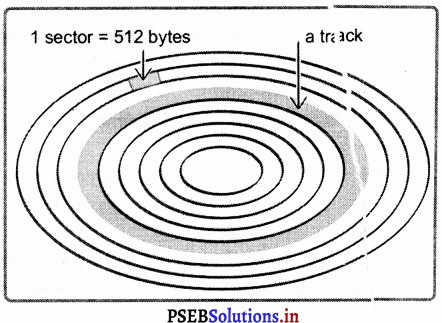
ਸੈਕਟਰਜ਼ (Sectors)
ਕਿਸੇ ਵੀ ਡਿਸਕ ਵਿਚ ਕਈ ਟਰੈਕ ਹੁੰਦੇ ਹਨ | ਹਰ ਟਰੈਕ ਨੂੰ ਛੋਟੇ-ਛੋਟੇ ਹਿੱਸਿਆਂ ਵਿਚ ਵੰਡਿਆ ਜਾਂਦਾ ਹੈ । ਇਹਨਾਂ ਹਿੱਸਿਆਂ ਨੂੰ ਸੈਕਟਰ ਕਿਹਾ ਜਾਂਦਾ ਹੈ । ਹਰ ਇਕ ਟਰੈਕ ਵਿਚ 8 ਜਾਂ ਉਸ ਤੋਂ ਵੱਧ ਸੈਕਟਰ ਹੋ ਸਕਦੇ ਹਨ । ਹਰੇਕ ਸੈਕਟਰ ਵਿਚ 512 ਬਾਈਟਸ ਸਟੋਰ ਕਰਨ ਦੀ ਸਮਰੱਥਾ ਹੁੰਦੀ ਹੈ ।
ਕਿਸੇ ਵੀ ਡਿਸਕ ਦੀ ਸਮਰੱਥਾ ਨੂੰ ਇਕ ਫਾਰਮੂਲੇ ਦੀ ਸਹਾਇਤਾ ਨਾਲ ਪਤਾ ਕੀਤਾ ਜਾ ਸਕਦਾ ਹੈ ; ਜਿਵੇਂ-
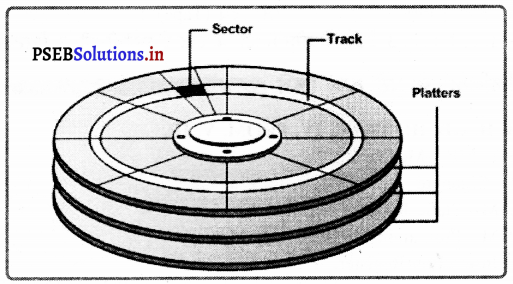
ਸਟੋਰੇਜ ਸਮਰੱਥਾ = ਕੁੱਲ ਤਲਾਂ ਦੀ ਗਿਣਤੀ × ਕੁੱਲ ਟਰੈਕਸ ਪ੍ਰਤੀਤਲ × ਕੁੱਲ ਸੈਕਟਰ ਪ੍ਰਤੀ ਟਰੈਕ × ਕੁੱਲ ਬਾਈਟਸ ਪ੍ਰਤੀ ਸੈਕਟਰ
ਇਸ ਪ੍ਰਕਾਰ ਸਟੋਰ ਇਸ ਗਣਨਾ ਵਿਚ ਸਹਾਇਤਾ ਕਰਦੇ ਹਨ ।








